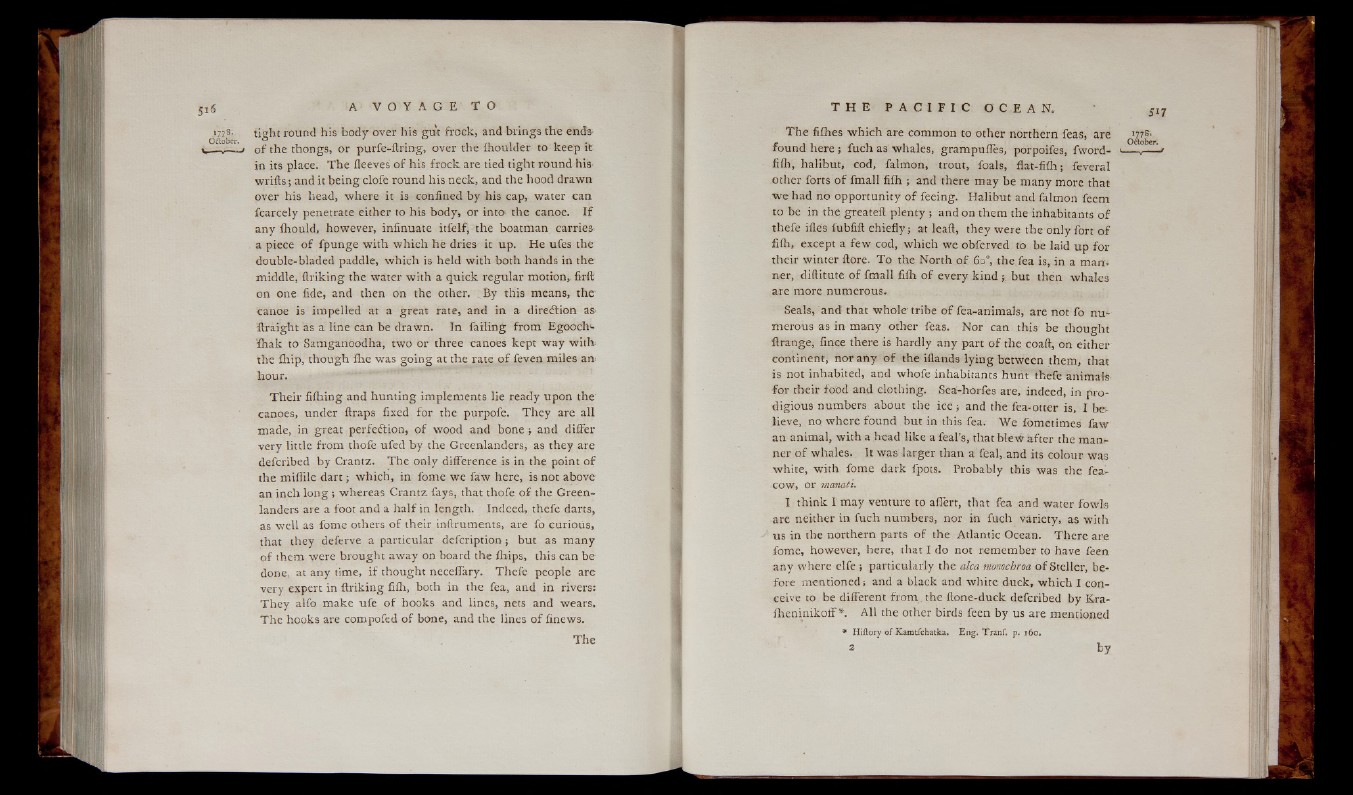
>778. tight round his body over his gu't frock, and brings the ends»
C5ftober. _ n . 1 ■ n 1 j - 1 w- v— of the thongs, or purie-itring, over the lhoulaer to keep it
in its place. T he fleeves o f his fro ck are tied tight round his
w rifts ; and it being clofe round his neck, and the hood drawn
over his head, where it is confined by his cap, water can
fcarcely penetrate either to his body, or in to the canoe. I f
any ihould, however, infinuate itfelf, the boatman carries»
a piece o f fpunge with w hich he dries it up. He ufes the
double-bladed paddle, which is held with both hands in the
middle, firikin g the water with a q u ick regular motion, firlt
on one fide, and then on the other. By this means, the
canoe is impelled at a great rate, and in a direction as>
ftraight as a line can be drawn. In failin g from Egooch-
ihak to Samganoodha, two or three canoes kept w a y with»
the ihip, though ihe was go in g at the rate o f feven miles an»
hour.
T h e ir fiihing and hunting implements lie ready upon the
canoes, under ftraps fixed for the purpofe. They are all
made, in great perfection, o f wood and bone and differ
very little from thole ufed by the Greenlanders, as they are
defcribed by Crantz. The only difference is in the point o f
the millile d a r t ; which, in fome we faw here, is not above
an inch long ; whereas Crantz fays, that thofe o f the Greenlanders
are a foot and a h a lf in length. Indeed, thefe darts,
as well as fome others o f their inftruments, are fo curious,
that they deferve a particular defcription; but as many
o f them were brought away on board the ihips, this can b e
done, at any time, i f thought neceffary. Thefe people are
very expert in firikin g filh, both in the fea, and in rivers:
T h e y alfo make ufe o f hooks and lines, nets and wears.
The hooks are compofed o f bone, and the lines o f finews.
T h e fifhes which are common to other northern feas, are '77?»
found here ; fuch as whales, grampuffes, porpoifes, fword- 1---- ,—
filh, halibut, cod, falmon, trout, foals, flat-fiih; feveral
other forts o f fmall filh ; and there may be many more that
w e had no opportunity o f feeing. Halibut and falmon feem
to be in the greateft plenty ; and on them the inhabitants o f
thefe illes fubfift ch ie fly ; at lead, they were the only fort o f
filh, except a few cod, which we obferved to be laid up for
their winter ftore- T o the North o f 60°, the fea is, in a man.
ner, diflitute o f fmall filh. o f every kind but then whales
are more numerous.
Seals, and that w h o le tribe o f fea-animals, are not fo numerous
as in many other feas. Nor can this be thought
ftrange, fince there is hardly any part o f the coaft, on either
continent, nor any o f the iflands ly in g between them, that
is not inhabited, and whofe inhabitants hunt thefe animals
fo r their food and clothing. Sea-horfes are, indeed, in prodigiou
s numbers about the ice ; and the fea-otter is, I be.
lieve, no. where found but in this fea. We fometimes faw
an animal, with a head like a feal’s, that b lew after the manner
o f whales. It was larger than a Teal, and its colour was
white, with fome dark fpots. Probably this was the fea-
cow, or manati.
I think I may venture to afiert, that fea and water fowls
are neither in fuch numbers, nor in fuch variety, as with
us in the northern parts o f the Atlantic Ocean. There are
fome, however, here, that I do not remember to have feen
any where elfe ; particularly the alca monechroa o f Steller, before
mentioned; and a black and white duck, which I conceive
to be different from the flone-duck defcribed by Kra-
iheninikoff *. All the other birds feen by us are mentioned
* Hiftory o f Kamtfchatka. E ng. Tranf. p. 160,
a by